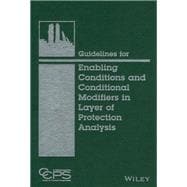This guideline clarifies key concepts and reinforces the limitations and the requirements of LOPA. The main scope of the guideline is to provide examples of CMs and ECs and to provide concrete guidance on the protocols that must be followed to use these concepts. The book presents a brief overview of Layer of Protection Analysis (LOPA) and its variations, and summarizes terminology used for evaluating scenarios in the context of a typical incident sequence. It defines and illustrates the most common types of ECs and CMs and shows how they interrelate to risk criteria as well as their application to other methods.








